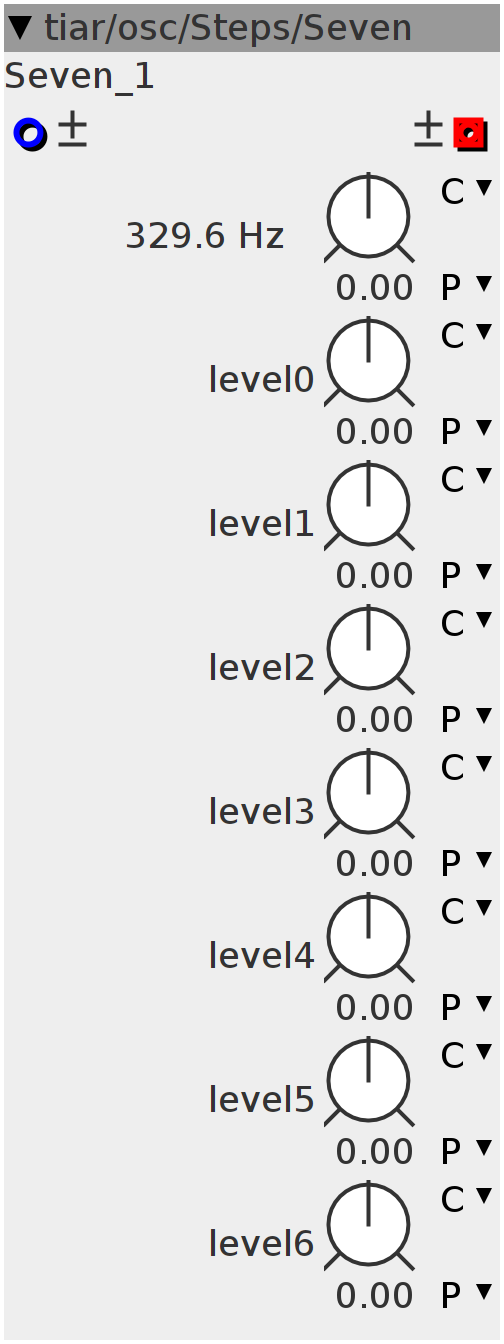Seven
The waveform of the SevenSteps oscillator is controlled by seven parameters: the seven steps levels. It allows to generate waveforms reminiscent of old pseudo digital synths (such as the RMI and it's digit harmonics based on Walsh functions). It is **anti aliased** with an algorithm that is based on both BLEPs and DPWs... i think it is quite original and efficient with this kind of waveforms. (the steppy signal goes through a second order leaky "analytic" integrator, when a transient occurs the state variable of the integrator is updated taking account of the subsample time of the transient - much like BLEPs -... at the end the signal is high passed with a second order differentiator - like a second order DPW...) It has an accompanying help patch file you can play with. The patch library/community/tiar/synths/EvolPad is more complex and uses 3 SixSteps oscillators on each of its 6 voices + LFO modulations of some levels to generate an evolving sound.
Inlets
frac32.bipolar pitch
Outlets
frac32buffer.bipolar out
Parameters
frac32.s.map.pitch pitch
frac32.s.map level0
frac32.s.map level1
frac32.s.map level2
frac32.s.map level3
frac32.s.map level4
frac32.s.map level5
frac32.s.map level6
float x, y, z0, z_1, z_2, p, dp, _dp;
float w0, w_1, w_2;
int cpt;
float seq[7];cpt = 0;
x = y = z_2 = z_1 = z0 = 0;
p = 0;int32_t idp;
MTOFEXTENDED(param_pitch + inlet_pitch, idp);
dp = 7.0f * (idp * (0.25f / (1 << 30)));
_dp = 1 / dp;
if (dp > 1)
dp = 1;
float dc = seq[0] = (float)param_level0;
dc += seq[1] = (float)param_level1;
dc += seq[2] = (float)param_level2;
dc += seq[3] = (float)param_level3;
dc += seq[4] = (float)param_level4;
dc += seq[5] = (float)param_level5;
dc += seq[6] = (float)param_level6;
dc *= 1.0f / 7;
for (int i = 0; i < 7; i++)
seq[i] -= dc;// phase increment
p += dp;
// _ _ _ _ _ _ _ _ _ _ _ _ _ _ _ _ _ _ _ _ _ _ _ _ _ _ _ _ _ _ _ _ _ _ _
// transition ?
if (p > 1) { // phase above 1
cpt++; // next step in sequence
if (cpt >= 7) // above 7 => wrap to 0
cpt = 0;
p -= 1; // reset phase
float alpha = p * _dp; // subsample time since the transition
//_ _ _ _ _ _ _ _ _ _ _ _ _ _ _ _ _ _ _ _ _ _ _ _
// integrator evolution before the transition
float _alpha = 1 - alpha;
float alpha_x = _alpha * x;
z0 += _alpha * (y + 0.5f * alpha_x);
y += alpha_x;
//_ _ _ _ _ _ _ _ _ _ _ _ _ _ _ _ _ _ _ _ _ _ _ _
// transition
x = seq[cpt];
//_ _ _ _ _ _ _ _ _ _ _ _ _ _ _ _ _ _ _ _ _ _ _ _
// integrator evolution after the transition
alpha_x = alpha * x;
z0 += alpha * (y + 0.5f * alpha_x);
y += alpha_x;
} else {
//_ _ _ _ _ _ _ _ _ _ _ _ _ _ _ _ _ _ _ _ _ _ _ _
// integrator evolution without transition
z0 += y + 0.5f * x;
y += x;
}
// _ _ _ _ _ _ _ _ _ _ _ _ _ _ _ _ _ _ _ _ _ _ _ _ _ _ _ _ _ _ _ _ _ _ _
// integrator leaks
y *= 0.999f;
z0 *= 0.999f;
// _ _ _ _ _ _ _ _ _ _ _ _ _ _ _ _ _ _ _ _ _ _ _ _ _ _ _ _ _ _ _ _ _ _ _
// 2nd order differenciation
outlet_out = (int32_t)(z0 + z_2 - 2 * z_1);
// _ _ _ _ _ _ _ _ _ _ _ _ _ _ _ _ _ _ _ _ _ _ _ _ _ _ _ _ _ _ _ _ _ _ _
// previous values
z_2 = z_1;
z_1 = z0;